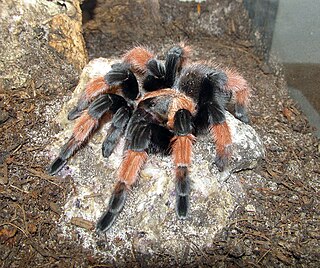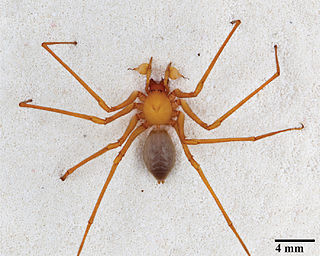
Brachypelma is a genus of spiders in the family Theraphosidae (tarantulas). They may have bodies up to 6 cm long with legs of similar or greater lengths. Some species have brightly colored legs, with red or orange marks and rings.
The arthropod leg is a form of jointed appendage of arthropods, usually used for walking. Many of the terms used for arthropod leg segments are of Latin origin, and may be confused with terms for bones: coxa, trochanter, femur, tibia, tarsus, ischium, metatarsus, carpus, dactylus, patella.

Ogoveidae is a family of harvestmen with three described species in one genus, Ogovea, which is found in equatorial West Africa.

Diguetia is a genus of coneweb spiders that was first described by Eugène Simon in 1895. Members of this genus are six-eyed spiders that are either white or patterned. They are common in the southwestern United States and Mexico, and one species is found in Argentina. In the United States, species have been found in Arizona, California, Nevada, New Mexico, and Texas. These spiders build a tubular retreat at the tip of their tent-like webs. Once an insect is caught in the web, the spider bites it and injects venom to stop its prey from moving, later wrapping it in silk. Both males and females use stridulation while mating, with females also stridulating when harassed. Two species of jumping spiders feed on its eggs. There are eleven Diguetia species.

Coneweb spiders (Diguetidae) are six-eyed haplogyne spiders that live in tangled space webs, fashioning a cone-like central retreat where they hide and lay eggs. It is a small family, containing only two genera with fifteen species and is confined to the New World, preferring deserts. Members of the genus Diguetia usually build their webs in shrubs or between cactus pads. They have the same eye arrangement as the venomous recluse spiders, but none are known to be harmful to humans.

Trogloraptor is a genus of large spiders found in the caves of southwestern Oregon. It is the sole genus in the family Trogloraptoridae, and includes only one species, Trogloraptor marchingtoni. These spiders are predominantly yellow-brown in color with a maximum leg span of 3 in (7.6 cm). They are remarkable for having hook-like claws on the raptorial last segments of their legs.

Caponiidae is a family of ecribellate haplogyne spiders that are unusual in a number of ways. They differ from other spiders in lacking book lungs and having the posterior median spinnerets anteriorly displaced to form a transverse row with the anterior lateral spinnerets. Most species have only two eyes, which is also unusual among spiders. A few species of Caponiidae variously have four, six or eight eyes. In some species the number of eyes will increase when the spiderling changes its skin as it grows towards adulthood.

Cubanops is a genus of Caribbean araneomorph spiders in the family Caponiidae first described by A. Sánchez-Ruiz, Norman I. Platnick & N. Dupérré in 2010. These spiders are wandering hunters, generally found at ground level, under stones, in leaf litter or in the soil, and have only been found in the West Indies.

Nops is a genus of medium-sized South American, Central American, and Caribbean spiders in the family Caponiidae, first described by Alexander Macleay in 1839. It has a great richness on the Caribbean islands, and most mainland species are located in high proportion toward the Caribbean coast. It likely has a neotropical distribution, though most species of South America are known only from the coast of Colombia and Venezuela, including the islands of Aruba, Curaçao, Bonaire and Trinidad.

Nops guanabacoae is a species of medium-sized caponiid spider with only two eyes and carapace uniformly orange. N. guanabacoae is the type species of genus Nops, more information on this article.

Eucteniza is a genus of trapdoor spiders in the family Euctenizidae containing at least 14 species occurring in Mexico and the southern United States. Species are distinguished by a softened rear portion of the carapace, and males possess large spines on the first two pairs of walking legs that are used to hold females during mating. Like other trapdoor spiders they create burrows with a hinged lid, from which they await passing insects and other arthropods to prey upon. Many species are known from only one or two localities, or from only male specimens. More species are expected to be discovered. Eucteniza is closely related to spiders of the genera Entychides and Neoapachella.
Kibramoa is a genus of North American plectreurid spiders that was first described by Ralph Vary Chamberlin in 1924.

Rabidosa hentzi is a small species of wolf spider found in North America. Most identified specimens were found in Florida, though some have been found in Georgia and Louisiana. Its color is like that of Rabidosa carrana or Rabidosa rabida, but it is distinguished from other Rabidosa species by its paler color and distinct striped pattern on its back. The cephalothorax is a pale brown-yellow color. Between these is a narrower bright yellow to white streak that extends past the eyes. The sternum and abdomen are both pale, though the upper sides are streaked and spotted with brown markings. The eyes are on a black band that extends back, fading into the pale brown. The spermathecae are round and the palea of the pedipalp has a sclerotized cap. Males and females have a similar face and chelicera, though that of males is usually lighter brown. Males will generally have fewer lateral brown markings on the abdomen than females. In the field, it can be distinguished from similar looking species by the thin yellow stripe on its back. Though usually a ground-dweller, due to scopula hairs on the tarsi and metatarsi, it can sometimes climb into shrubs and bushes. It is the only wolf spider that climbs up into the higher vegetation in open woodland.
Agelenella is a genus of Asian funnel weavers containing the single species, Agelenella pusilla. It was first described by Pekka T. Lehtinen in 1967, and has only been found in Yemen.
Pseudanapis is a genus of araneomorph spiders in the family Anapidae, first described by Eugène Simon in 1905. It is a senior synonym of "Gossiblemma" and "Amrishoonops".
Orthonops is a genus of North American araneomorph spiders in the family Caponiidae, first described by R. V. Chamberlin in 1924.

Tarsonops is a genus of araneomorph spiders in the family Caponiidae, first described by Ralph Vary Chamberlin in 1924.

Hermatobates is a genus of wingless marine bugs placed as the sole genus in the family Hermatobatidae that are sometimes known as coral-treaders. They are quite rare and known only from coral reefs in the Indo-Pacific region. During low tide, they move over the water surface not unlike the more familiar water-striders around coral atolls and reefs and stay submerged in reef crevices during high tide.

Tliltocatl is a genus of North American tarantulas that was split off from Brachypelma in 2020. They are also large burrowing tarantulas, but don't have the striking red leg markings of Brachypelma species. A female T. vagans can grow up to 50 mm (2.0 in) long and legs can get as long as 55 mm (2.2 in). They are found predominantly in Mexico, with some species native to Central America. The name is derived from two Nahuatl words, "tlil", meaning "black", and "tocatl", meaning "spider". Habitat destruction and collection for the pet trade has led to this and Brachypelma to be protected under International Convention on International Trade of Endangered Species rules, beginning with B. smithi.












